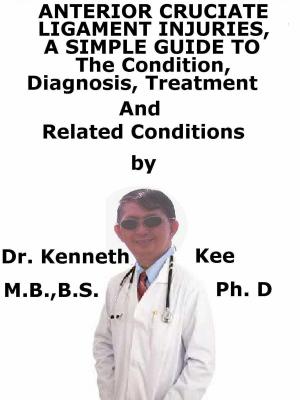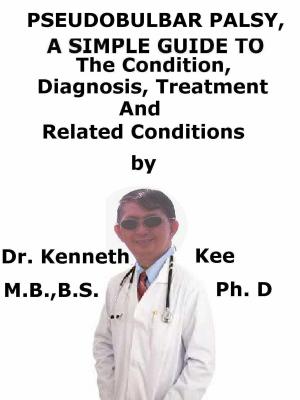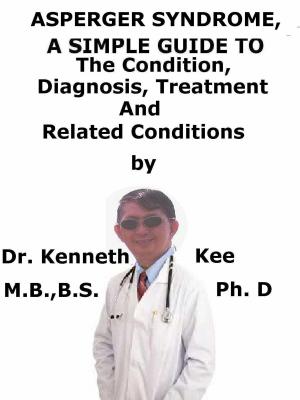Transverse Myelitis, A Simple Guide To The Condition, Treatment And Related Diseases
Nonfiction, Health & Well Being, Health, Ailments & Diseases, Nervous System & the Brain, Medical, Specialties, Internal Medicine, Neurology| Author: | Kenneth Kee | ISBN: | 9781370095131 |
| Publisher: | Kenneth Kee | Publication: | October 4, 2016 |
| Imprint: | Smashwords Edition | Language: | English |
| Author: | Kenneth Kee |
| ISBN: | 9781370095131 |
| Publisher: | Kenneth Kee |
| Publication: | October 4, 2016 |
| Imprint: | Smashwords Edition |
| Language: | English |
Transverse myelitis is a neurological disorder caused by inflammation across both sides of one level or segment of the spinal cord.
Attacks of inflammation can damage or destroy myelin, the fatty insulating substance that covers nerve cell fibers.
This damage causes nervous system scars that interrupt communications between the nerves in the spinal cord and the rest of the body.
Most patients will have only one episode of transverse myelitis; a small percentage may have a recurrence.
The segment of the spinal cord at which the damage occurs determines which parts of the body are affected.
a. Nerves in the cervical (neck) region control signals to the neck, arms, hands, and muscles of breathing (the diaphragm).
b. Nerves in the thoracic (upper back) region relay signals to the torso and some parts of the arms.
c. Nerves at the lumbar (mid-back) level control signals to the hips and legs.
d. Finally, sacral nerves located within the lowest segment of the spinal cord relay signals to the groin, toes and some parts of the legs.
Damage at one segment will affect function at that segment and segments below it.
In patients with transverse myelitis, demyelination usually occurs at the thoracic level, causing problems with leg movement and bowel and bladder control, which require signals from the lower segments of the spinal cord.
Transverse myelitis often develops following viral and bacterial infections and are related to autoimmune diseases such as SLE and Sjogren’s syndrome.
Transverse myelitis represents the first symptom of an underlying demyelinating disease of the central nervous system such as multiple sclerosis (MS) or neuromyelitis optica (NMO).
Symptoms of transverse myelitis include a loss of spinal cord function over several hours to several weeks.
What usually begins as a sudden onset of lower back pain, muscle weakness, or abnormal sensations in the toes and feet can rapidly progress to more severe symptoms, including paralysis, urinary retention, and loss of bowel control.
Although some patients recover from transverse myelitis with minor or no residual problems, others suffer permanent impairments that affect their ability to perform ordinary tasks of daily living.
The spinal cord MRI will almost always confirm the presence of a lesion within the spinal cord, whereas the brain MRI may provide clues to other underlying causes especially MS.
No effective cure currently exists for people with transverse myelitis.
Treatments are designed to reduce spinal cord inflammation and manage and alleviate symptoms.
TABLE OF CONTENT
Introduction
Chapter 1 Transverse Myelitis
Chapter 2 More Facts about Transverse Myelitis
Chapter 3 Treatment of Transverse Myelitis
Chapter 4 Sarcoidosis
Chapter 5 SLE
Chapter 6 Multiple Sclerosis
Chapter 7 Sjoren Disease
Epilogue
Transverse myelitis is a neurological disorder caused by inflammation across both sides of one level or segment of the spinal cord.
Attacks of inflammation can damage or destroy myelin, the fatty insulating substance that covers nerve cell fibers.
This damage causes nervous system scars that interrupt communications between the nerves in the spinal cord and the rest of the body.
Most patients will have only one episode of transverse myelitis; a small percentage may have a recurrence.
The segment of the spinal cord at which the damage occurs determines which parts of the body are affected.
a. Nerves in the cervical (neck) region control signals to the neck, arms, hands, and muscles of breathing (the diaphragm).
b. Nerves in the thoracic (upper back) region relay signals to the torso and some parts of the arms.
c. Nerves at the lumbar (mid-back) level control signals to the hips and legs.
d. Finally, sacral nerves located within the lowest segment of the spinal cord relay signals to the groin, toes and some parts of the legs.
Damage at one segment will affect function at that segment and segments below it.
In patients with transverse myelitis, demyelination usually occurs at the thoracic level, causing problems with leg movement and bowel and bladder control, which require signals from the lower segments of the spinal cord.
Transverse myelitis often develops following viral and bacterial infections and are related to autoimmune diseases such as SLE and Sjogren’s syndrome.
Transverse myelitis represents the first symptom of an underlying demyelinating disease of the central nervous system such as multiple sclerosis (MS) or neuromyelitis optica (NMO).
Symptoms of transverse myelitis include a loss of spinal cord function over several hours to several weeks.
What usually begins as a sudden onset of lower back pain, muscle weakness, or abnormal sensations in the toes and feet can rapidly progress to more severe symptoms, including paralysis, urinary retention, and loss of bowel control.
Although some patients recover from transverse myelitis with minor or no residual problems, others suffer permanent impairments that affect their ability to perform ordinary tasks of daily living.
The spinal cord MRI will almost always confirm the presence of a lesion within the spinal cord, whereas the brain MRI may provide clues to other underlying causes especially MS.
No effective cure currently exists for people with transverse myelitis.
Treatments are designed to reduce spinal cord inflammation and manage and alleviate symptoms.
TABLE OF CONTENT
Introduction
Chapter 1 Transverse Myelitis
Chapter 2 More Facts about Transverse Myelitis
Chapter 3 Treatment of Transverse Myelitis
Chapter 4 Sarcoidosis
Chapter 5 SLE
Chapter 6 Multiple Sclerosis
Chapter 7 Sjoren Disease
Epilogue















